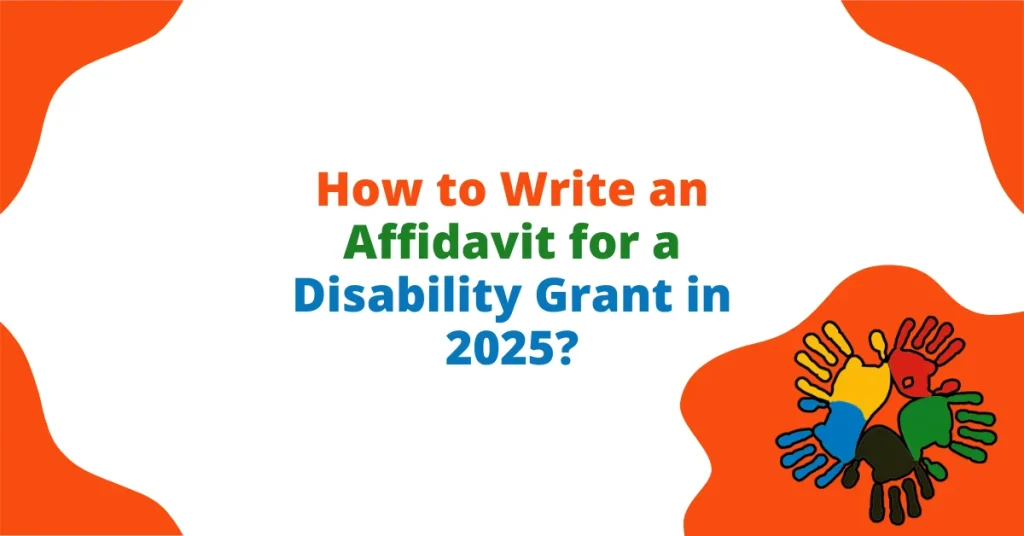Need to apply for a disability grant but unsure how to write the affidavit? Many South Africans face delays or rejections due to incomplete or incorrect affidavits.
In 2025, SASSA still requires a valid, signed affidavit with your application here’s how to complete it the right way, using simple steps and real information.
Download PDF File from SASSA’s Official Website.
What Is a Disability Grant Affidavit?
A disability grant affidavit is a legal document that confirms your personal and financial situation. It’s required by the South African Social Security Agency (SASSA) to process disability grant applications under the Social Assistance Act.
This affidavit must include:
- Your full name and ID number
- Details about your income, assets, and marital status
- A declaration confirming the truth of your statements
- A commissioner of oaths’ signature to make it official
Why SASSA Needs the Affidavit?
SASSA uses your affidavit to:
- Confirm that you qualify for the disability grant
- Check if you receive any income
- Ensure you’re not living in a state-funded facility
- Protect the system from fraud or misreporting
Step-by-Step Guide to Writing a Disability Grant Affidavit (2025)
1. Start with Personal Details
Include your personal identification at the top of the affidavit:
- Full name and surname
- 13-digit South African ID number
- Age
- Home address (physical, not postal)
- Postal code
2. Declare Your Purpose
State clearly:
“I, the undersigned, am applying for a SASSA Disability Grant and confirm I am not living in any institution funded by the government.”
This is a required part of your statement.
3. Confirm Marital Status
Tick or mark the correct marital status:
- Married / Unmarried
- In community of property / Out of community
- Customary union / Civil union
- Divorced / Widowed
- Deserted for more than 3 months
💡 Tip: If married, divorced, or widowed mention your partner or ex-partner’s full name and ID number. Also attach any available documents like:
- ID copies
- Death certificate
- Divorce decree
If you don’t have these, explain why in the space provided.
4. Income Disclosure Section
Mark any sources of income that apply to you, your spouse, or dependants:
- Salary or wages
- Farming or business profits
- Trust payments or inheritance
- Property rights or rental income
- Pensions or annuities
- Interest from bank accounts or investments
- Payments from RSA or international organisations
If you or your spouse don’t have income, write how you survive (e.g. family support, community donations, church help).
5. Declare Your Assets
Tick all asset boxes that apply to you or your spouse:
- Occupied or unoccupied property
- Investments, shares, or loans
- Cash on hand
- Company shares or capital
- Insurance or endowment payouts
- Lump sums or annuities
If neither of you owns any assets, tick the box:
“I / we do not own ANY assets”
6. Sworn Declaration
End the affidavit by writing:
“I declare that the information provided is true and correct to the best of my knowledge. I am willing to take an oath and confirm this statement is binding on my conscience.”
7. Final Step – Signature and Certification
Take the completed affidavit to any:
- Police Station (SAPS)
- Court
- Post Office
- Legal Aid office
A Commissioner of Oaths must:
- Check your ID
- Confirm you understand the contents
- Watch you sign (or take your thumbprint)
- Fill in their own details, rank or force number
- Stamp and date the form
Without this certification, your affidavit is not valid.
Extra Tips to Avoid Delays
- Always use factual, clear answers – no blank spaces
- Write in black ink and block letters if handwritten
- Make sure your ID number and signature are correct
- Use Annexure I-2 format if provided by the SASSA office
- Attach supporting documents (if needed)
When Must You Submit an Affidavit?
You must submit an affidavit:
- When applying for a new disability grant
- If your circumstances change (marital status, income, etc.)
- When SASSA requests it during a review
Why SASSA Rejects Affidavits?
Your affidavit might be rejected if:
- It’s not signed in front of a commissioner
- You leave out key details (income, ID, spouse info)
- You use false or vague statements
- The form is not readable or not stamped
Conclusion
Writing an affidavit for a SASSA disability grant in 2025 is simple if you follow the correct steps. Use your ID, declare your income, and confirm your marital status honestly. Then visit a commissioner of oaths to make it official. This document plays a big role in getting your grant approved so fill it out with care and accuracy.
Frequently Asked Questions
Q. Where can I get the affidavit form for a disability grant?
You can ask for the form at any SASSA office or use the Annexure I-2 format.
Q. Do I need to write the affidavit myself?
Yes, but you can get help filling it out. A SASSA officer or legal aid worker can guide you.
Q. Can I use a digital affidavit?
No. It must be a signed physical copy with a commissioner’s stamp.
Q. What if I have no income or assets?
You must state how you survive family support, donations, or community aid.
Q. Is the affidavit a once-off requirement?
No. SASSA may ask for a new affidavit during reviews or when your details change.
